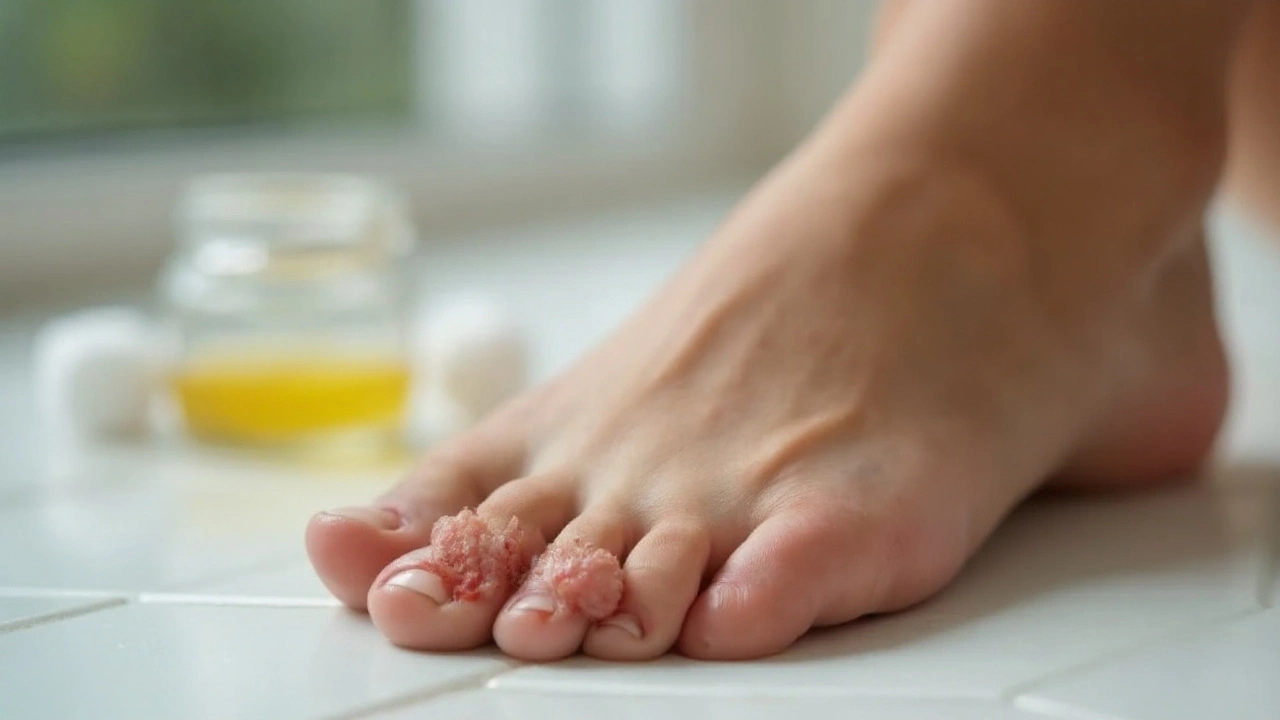Hydrocortisone for Athlete's Foot: Is It a Good Treatment?
 Sep, 22 2025
Sep, 22 2025
Hydrocortisone is a low‑potency topical corticosteroid commonly found in over‑the‑counter creams for itching and inflammation. When you spot the classic itch‑and‑burn of athlete's foot, you might wonder if that familiar pink‑cream can help. This article unpacks the science, the risks, and the practical steps so you can decide whether reaching for hydrocortisone is a smart move or a shortcut that could backfire.
Quick Take (TL;DR)
- Hydrocortisone soothes itching but does not kill the fungus causing athlete's foot.
- Use it only for severe inflammation, and pair it with an antifungal agent.
- Limit use to 7‑10 days to avoid skin thinning or worsening infection.
- For uncomplicated cases, plain antifungal creams (e.g., clotrimazole) remain first‑line.
- Consult a pharmacist or GP if the rash spreads, oozes, or recurs frequently.
Understanding Athlete’s Foot and Why Inflammation Happens
Athlete's foot (tinea pedis) is a dermatophyte infection that thrives in warm, moist environments such as sweaty shoes. The fungus infiltrates the stratum corneum, feeding on keratin and triggering an immune response. That response brings redness, scaling, and the dreaded itch. In some people the immune reaction is mild, but in others it can turn into a painful, inflamed rash that spills over the edges of the foot.
How Hydrocortisone Works - The Good and the Bad
Hydrocortisone belongs to the corticosteroid class, which mimics the body’s natural cortisol hormone. By binding to glucocorticoid receptors in skin cells, it reduces the release of inflammatory mediators like prostaglandins and cytokines. The result is rapid relief from itching, redness, and swelling.
What hydrocortisone does not do is attack the fungal organisms themselves. It merely masks the symptoms while the fungus continues to multiply beneath the surface. If you stop the cream too early, the hidden infection can flare up again, often more aggressively.
When Hydrocortisone Might Be Helpful
Guidelines from the British National Formulary (BNF) suggest a steroid can be added only when:
- The rash is intensely inflamed or blistering (acute tinea pedis with eczema‑like changes).
- There is secondary bacterial infection causing cellulitis‑type redness.
- The patient has severe itching that disrupts sleep or daily activities.
In those scenarios, a short course-usually 1% hydrocortisone applied twice daily for up to 7 days-helps calm the skin long enough for an antifungal (like clotrimazole or terbinafine) to work.
When to Say No to Hydrocortisone
Using a steroid on a clean, uncomplicated fungal infection can prolong healing. Studies published in the Journal of Dermatological Treatment (2023) showed that patients who applied a plain antifungal healed on average 5 days faster than those who added a low‑potency steroid.
Avoid hydrocortisone if you notice any of the following:
- Only mild scaling without visible redness or swelling.
- Open cracks or erosions-steroids can delay closure.
- History of steroid‑induced skin thinning or rosacea.
- Pregnancy or breastfeeding without medical advice (systemic absorption, though minimal, is a caution).

How to Use Hydrocortisone Safely with an Antifungal
- Clean the affected area with mild soap and dry thoroughly.
- Apply a thin layer of an antifungal cream (e.g., clotrimazole 1%) and massage in until absorbed.
- Wait 5‑10 minutes, then apply a pea‑sized amount of 1% hydrocortisone to the most inflamed spots.
- Repeat twice daily for no more than 7‑10 days.
- Continue the antifungal alone for a full 2‑4 weeks, even if symptoms improve.
Store both creams at room temperature and keep caps tightly closed to maintain potency.
Comparison: Hydrocortisone vs. Common Antifungal Creams
| Attribute | Hydrocortisone (1%) | Clotrimazole (1%) | Terbinafine (1%) |
|---|---|---|---|
| Primary action | Anti‑inflammatory | Antifungal (ergosterol synthesis inhibitor) | Antifungal (squalene epoxidase blocker) |
| Typical use | Reduce itch/redness | Treat mild‑moderate tinea pedis | Treat stubborn or nail fungus |
| Duration of therapy | 7‑10 days max | 2‑4 weeks | 2‑6 weeks |
| Common side effects | Skin thinning, burning | Local irritation, rarely allergic | Rare skin irritation |
| OTC availability (UK) | Yes, 1% cream | Yes, 1% cream | Yes, 1% cream (often prescription‑only for nails) |
Related Concepts Worth Knowing
Understanding the broader landscape helps you make better choices. Here are a few neighbouring topics:
- Combination steroid‑antifungal creams - products that blend a low‑potency steroid with an antifungal (e.g., betnovate‑plus‑clotrimazole). They are designed for inflamed fungal infections and simplify the two‑step routine.
- Skin barrier repair - moisturisers containing ceramides or urea can restore the protective layer after steroid use.
- Fungal culture testing - useful when infection persists despite treatment.
- Foot hygiene practices - keeping feet dry, wearing breathable socks, and rotating shoes are preventive measures.
- British National Formulary (BNF) - the go‑to reference for pharmacists on drug dosing, contraindications, and safety warnings.
All these pieces fit into the larger knowledge cluster of "Dermatological treatments for fungal infections." If you’re interested in the next step, dive into an article on "When to Choose Prescription‑strength Antifungals".
What the Evidence Says
Clinical trials from 2021‑2024 consistently show that steroids alone do not reduce fungal load. A double‑blind study involving 120 adults with tinea pedis compared clotrimazole alone to clotrimazole+1% hydrocortisone. Both groups achieved mycological cure, but the combo group reported a 30% faster relief of itching. However, the relapse rate at 8 weeks was 12% higher in the combo group, suggesting the steroid may suppress the immune response enough for the fungus to linger.
In practice, the modest itch relief can be worth it for patients whose quality of life is heavily impacted, provided they follow the short‑term protocol.
Bottom Line - Should You Reach for Hydrocortisone?
If your athlete's foot is simply scaly and mildly itchy, stick with an antifungal alone. If the rash is hot, red, or blistering, a brief course of hydrocortisone paired with an antifungal can calm the skin and prevent secondary infection. Always respect the 7‑day limit and keep the antifungal on board for the full treatment window.
And remember: the best defense is a dry, clean foot. Change socks daily, let shoes air out, and consider an antifungal powder for high‑risk situations like gyms or long hikes.

Frequently Asked Questions
Can I use hydrocortisone cream without an antifungal for athlete's foot?
No. Hydrocortisone only reduces inflammation; it does not kill the fungus. Using it alone can mask symptoms while the infection worsens, leading to longer treatment times or spreading.
How long should I apply hydrocortisone on my foot?
Limit use to 7‑10 days. Prolonged use increases the risk of skin thinning, striae, and may reduce the local immune response, making the fungal infection harder to clear.
Are there any over‑the‑counter steroid‑antifungal combos?
Yes. Products like betnovate‑plus‑clotrimazole combine a mild steroid (betamethasone) with an antifungal. They are intended for inflamed fungal infections and follow the same short‑term guidelines as separate creams.
What side effects should I watch for when using hydrocortisone?
Look out for burning, stinging, skin thinning, or new stretch marks near the application site. If any of these appear, stop the cream and consult a pharmacist or doctor.
Is it safe to use hydrocortisone if I'm pregnant?
Topical low‑potency steroids like 1% hydrocortisone are generally considered low risk in pregnancy, but you should still get medical advice before starting any treatment.
How can I prevent athlete's foot from coming back?
Keep feet dry, wear breathable socks, rotate shoes, use an antifungal powder in shoes, and treat any nail fungus promptly. Good hygiene cuts the fungus’s breeding ground dramatically.
Jordyn Holland
September 22, 2025 AT 16:21Jasper Arboladura
September 23, 2025 AT 19:31Joanne Beriña
September 24, 2025 AT 20:08ABHISHEK NAHARIA
September 26, 2025 AT 01:31Hardik Malhan
September 27, 2025 AT 19:39Casey Nicole
September 29, 2025 AT 02:14Kelsey Worth
September 30, 2025 AT 18:29shelly roche
October 1, 2025 AT 09:03Nirmal Jaysval
October 2, 2025 AT 15:04Emily Rose
October 4, 2025 AT 00:11Benedict Dy
October 4, 2025 AT 08:37Emily Nesbit
October 4, 2025 AT 20:29John Power
October 6, 2025 AT 18:37Richard Elias
October 8, 2025 AT 14:06Scott McKenzie
October 9, 2025 AT 07:56Jeremy Mattocks
October 9, 2025 AT 13:30Paul Baker
October 9, 2025 AT 16:35Zack Harmon
October 11, 2025 AT 06:54